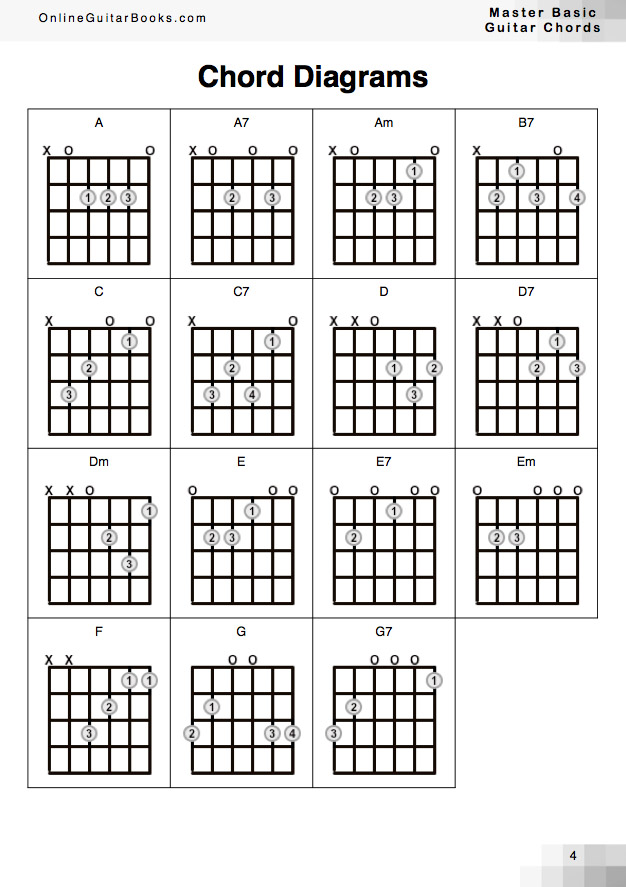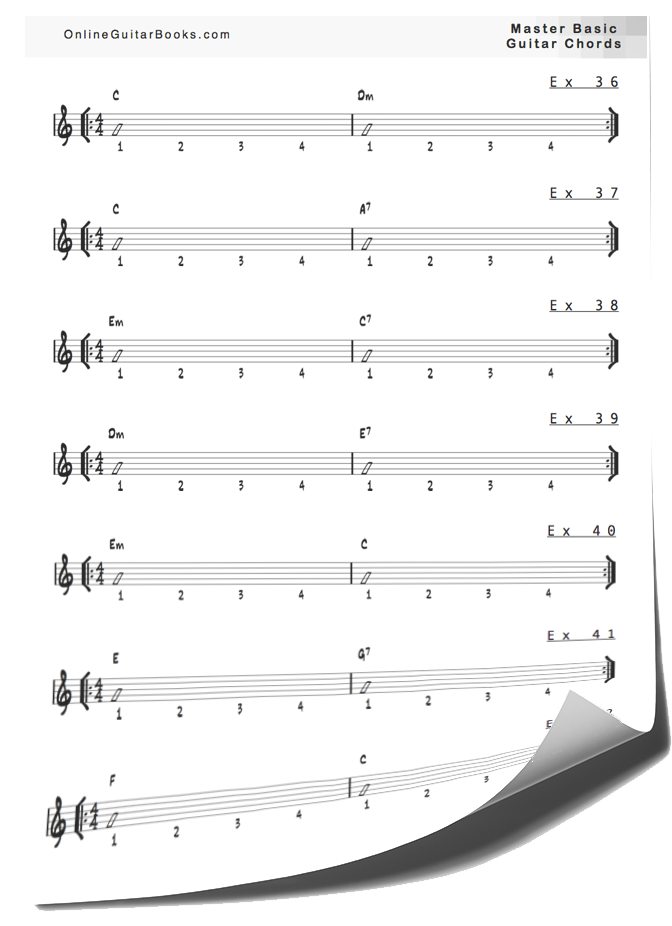
How many chords do you need to know? That’s sort of a ‘how long is a piece of string?’ question, but in this case there is an answer, depending on what you’re trying to achieve.
There are 15 chords that when mastered, will allow you to play thousands upon thousands of songs. These 15 chords are ‘open chords’, which means they’re played in the first position, and use at least some open strings. There are 15 open chords that just happen to get used more than the others. It’s basically the 80/20 rule – most of the time, we use a small percentage of available chords.
Because these 15 chords are relatively easy to play, and because the open strings give them a beautiful, resonating character, they get used most often, which makes them more popular. It’s a self-perpetuating cycle.
In this lesson, we’re going to look inside the book ‘Master Basic Guitar Chords‘, and how it can help you master the 15 common open chords. This isn’t a sales page for the book. We’re going to look at all 15 chords, play through a song and play through some exercises as well.
Why The Book Was Written
I had already written a book on open chords and strumming called ‘Open Chords Made Easy‘, before writing this one. OCME contains 23 guitar duets, as well as a comprehensive guide to chords and strumming. You can read the lessons from the book here, but basically the book breaks down exactly what strumming is, and how it relates to rhythm. I had seen a lot of students who were confused by how to strum and frustrated by the lack of guidance in that area. OCME contains pieces of music with strumming guides. There are also a lot more chords included in OCME – lots of variations on the 15 common open chords.
What I realised though, is that one of the main reasons why people struggle with executing strumming rhythms, actually has to do with their chord playing hand. You can learn how to play chords and be able to play different strumming rhythms, but if you can’t effectively change from one chord to another, when you need to, it doesn’t matter how strong your sense of rhythm is. There will be a break in the music and it will sound and feel like the rhythm is unstable.
Learning chords is easy. Someone who has never played a guitar before can technically pick one up, learn where to put his or her fingers and then change from one chord to another. The challenge is being able to do it in time, with clarity and confidence, in a piece of music. That’s where ‘Master Basic Guitar Chords‘ comes in.
What Is ‘Master Basic Guitar Chords’?
The book itself contains 15 traditional songs as well as 105 two-chord exercises. All of the songs and exercises use only the 15 common open chords. The way to master the chords is through repetition. It would be nice if you could simply learn how to play a chord and then had the ability to use it freely in a song forever more, but that rarely happens. You master chords by using the same ones, over and over again, in different songs, so that they become second nature.
That’s what this book provides – a way to use the 15 chords over and over again, by playing along with actual music. This is a very important point – by using actual music that is fun to play, practising these chords becomes enjoyable. In fact, it doesn’t even feel like practice when you are simply trying to play along with a piece of music.
The Songs
The songs are a collection of traditional folk songs from different countries and time periods. They have been rerecorded for this book, and along with the chord charts, the audio tracks are the perfect accompaniments. The 15 songs are:
- La Paloma (Sebastián Iradier)
- Scarborough Fair (English Folk)
- In The Pines (American Folk)
- Wade In The Water (Negro Spiritual)
- Amazing Grace (Christian Hymn)
- Pretty Saro (English Folk)
- The Parting Glass (Irish Folk)
- House Of The Rising Sun (American Folk)
- Henry Martin (Scottish Folk)
- Greensleeves (English Folk)
- Mountains Of Mourne (Percy French)
- Londonderry Air (Irish Folk)
- Waltzing Matilda (Banjo Paterson)
- Hard Times Come Again No More (Stephen Foster)
- John Barleycorn (English Folk)

105 Exercises
There are 105 exercises in the book. Each exercise is made up of two chords and simply involves holding the first chord for four beats, then holding the second chord for four beats, then repeating.
When we talk about chord changes, we’re really talking about a unique movement from one chord to another. Each chord change is a unique change between two chords. How many chord changes are possible with a pool of 15 chords? 105.
If you play through the 105 two-chord exercises in this book, you will cover every chord change possible (using the 15 chords). Playing exercises isn’t necessarily as fun as playing songs, so that’s why the exercises have been distributed evenly throughout the book, in between the pieces of music. How you approach the exercises is up to you. You can use them as warm-ups, or focus on exercises that you find particularly difficult, as a way of overcoming technical challenges.
15 Chords
We’re going to look at a song from the book, but before we do, here are the 15 chords that you need to know.

If you’re not sure how to read chord charts, how to read chord diagrams.
Pretty Saro
We’re going to look at one of the songs from the book. This will allow you to understand the format of the songs and how the chords fit in. Let’s look at the chord chart for ‘Pretty Saro’, which is a traditional English folk song.

As you can see, there is a basic chord chart, containing chords, rhythms and counts. Let’s isolate the first line of the chord chart and analyse what’s going on.

The chords (above the staff) simply tells you which chord to play. On the first line we have the following:
Each chord is aligned to a rhythm. If you have read sheet music before and are familiar with rhythmic notation, you can simply follow the rhythm and change chords at the appropriate point. However, you do not need to be able to read notation. That’s where the counting comes in. As you can see, there is counting underneath the staff. Each chord is aligned to a count, which means all you need to be able to do is count and change chords on certain counts.
If you are not familiar with pulse, meter and counting, read this lesson.
Looking at the first line of ‘Pretty Saro’, you can see that there is a chord on the ‘1’ and ‘4’ of each bar, except for the fourth bar, where there is a chord played only on the first beat.
This is how it sounds when counting out loud and playing.
It should be pretty obvious as to what’s going on based on the sheet music and audio example. This is a great way to practise the pieces. Start out by counting out loud and playing through the chord changes, using the correct rhythm. This will allow you to become familiar with the chords and rhythms, so that playing with the recordings becomes easier. Let’s look at the entire chord chart again, with the full recording below.

You should practise playing along. Hopefully you get that sense of playing music and feeling like your chords are fitting in with the recording. That’s the beauty of playing along with these pieces – you get to work on chord changes in a simple, uncomplicated way, with the enjoyable challenge of keeping up with the audio track.
If you find that the recording is too fast to begin with, you can always go back to counting by yourself, or using a metronome at a slower speed. There are also slowed-down recordings that come with the book.
The Chord Exercises
Let’s finish by looking at a few exercises. As I mentioned earlier, each exercise has two chords, so that you can repetitively practise changing between those two chords. The exercises are put into groups of seven (not necessarily related) and distributed in between songs.
let’s look at one group of seven exercises.

Practising these exercises is pretty simple. You should first practise an exercise by simply moving from one chord to the other, in slow motion, even without strumming, and just focus on making the transition between chords as efficient and smooth as possible. You should then put on a metronome and loop the exercise, like in the following examples:


Although this lesson contains audio examples of two exercises, the book does not have audio examples (only play along tracks for the songs). This is because you don’t really need audio examples for the exercises. If you have a metronome, that’s all you need.
Each exercise involves holding each chord for four beats, but if you want to get creative, you can always spice things up by playing a different rhythm for each chord.
I’ll post a link to the book when it’s available for purchase.
Here’s another track from the book – ‘Hard Times Come Again No More’
